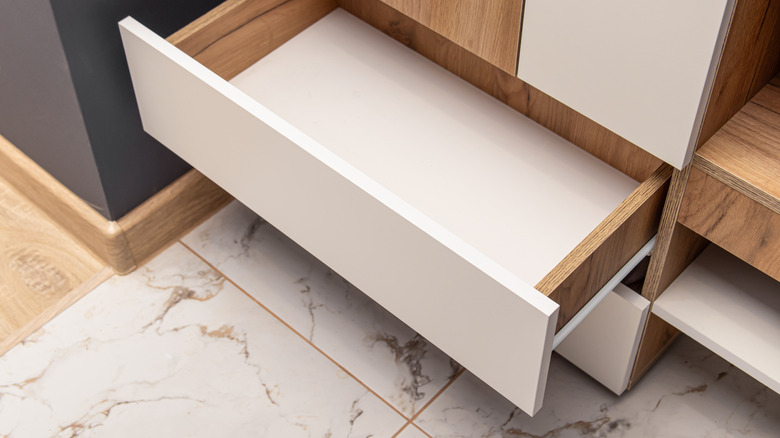The Bathroom Staple That'll Help You Quickly Fix A Stuck Drawer
When a drawer is functioning well, you likely don't think about how smoothly it opens and closes. A stuck drawer, however, is an exercise in tugging, pulling, and frustration. An unexpected helper in this situation is a staple item you may already have on hand in your bathroom medicine cabinet: petroleum jelly, which is commonly sold under the brand name Vaseline. There are a variety of handy ways to use Vaseline around the house. A bit applied to your drawer's edges, bottoms, or sides can have it sliding easily in and out in a jiffy.
Of course, how well this works depends on a few factors, like what's causing your drawer to be stuck in the first place. The first thing you should do to fix a stuck drawer is remove the drawer from its casing — its home in your piece of furniture — and check to see if there's some physical object that's getting in its way. If there is, take that obstacle out, and your drawer should function fine. It's also possible that some household dust and dirt has accumulated behind or under your drawer to the point that it's impeding its functioning; if that's the case, the solution is to go beyond decluttering and organizing your cabinet drawers and actually clean behind them. If you've got a wooden drawer that's sticking because it has swollen due to moisture and humidity, a hardcore solution is to sand off some wood so it functions well again, but you also risk sanding off too much.
Apply Vaseline to your drawer slides
A common cause of stuck drawers, however, is issues with sliding — whether that's the drawer itself sliding along the sides and bottoms of its case, or with physical drawer slides. Sometimes, your drawer has just been bumped out of alignment in the tracks for its slides. The solution for that problem is either to pull the drawer all the way out and then back in a couple of times so it naturally realigns, or to remove the drawer and reset it properly into the tracks. Otherwise, this is where the petroleum jelly comes in.
Vaseline helps your drawer slide better by acting as a lubricant. If your drawer has slide hardware, you'll want to first take the drawer out of its home and consider using a bit of rubbing alcohol to clean the slides, taking care of anything that's blocking their tracks, before drying them off with a soft cloth. Then, put a thin layer of Vaseline onto all parts of the slides, particularly any joints or ball bearings. Reinstall the drawer and slide it in and out a few times, both to more evenly spread the petroleum jelly along all parts of the slides and to make sure the drawer's now functioning properly. If it's still not working well, try applying a bit more Vaseline. Just make sure you don't apply too much, to avoid globs of unattractive buildup. This works especially well on metal slides; just be aware that you'll likely have to reapply the Vaseline on a semi-regular schedule, such as six months to a year.
Other lubricant options for stuck drawers, and some cautions
You can also apply Vaseline everywhere the drawer touches the frame of your cabinet, dresser, or other piece of furniture, such as your drawer bottoms and sides. This can be helpful for furniture that's constructed without any drawer slide hardware. Apply a thin layer of Vaseline and, to avoid potential splinters from wood furniture, consider using an applicator other than your finger. If you need more after you've tested whether your drawer is sliding easily, apply again, making sure to address any grooves that the drawer should slide in.
While you can also use other lubricants, such as beeswax, wax from a candle, or even a piece of plain soap, on your drawers or drawer slides, petroleum jelly will last longer without drying out. Oil-based lubricants, such as food-grade mineral oil carefully applied in a thin layer, can work okay on wooden furniture, but are more likely to attract dirt than petroleum jelly. You should also note that slide manufacturer Accuride says to avoid lubricants containing molybdenum sulfide or graphite on standard ball-bearing slides. You may want to check with the manufacturer before using lubricants on things like kitchen appliances that use specialty slides, such as when you're struggling to open a stuck oven drawer.


